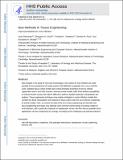New Methods in Tissue Engineering: Improved Models for Viral Infection
Author(s)
Ramanan, Vyas; Scull, Margaret A.; Sheahan, Timothy P.; Rice, Charles M.; Bhatia, Sangeeta N
DownloadBhatia_New methods.pdf (399.3Kb)
OPEN_ACCESS_POLICY
Open Access Policy
Creative Commons Attribution-Noncommercial-Share Alike
Terms of use
Metadata
Show full item recordAbstract
New insights in the study of virus and host biology in the context of viral infection are made possible by the development of model systems that faithfully recapitulate the in vivo viral life cycle. Standard tissue culture models lack critical emergent properties driven by cellular organization and in vivo–like function, whereas animal models suffer from limited susceptibility to relevant human viruses and make it difficult to perform detailed molecular manipulation and analysis. Tissue engineering techniques may enable virologists to create infection models that combine the facile manipulation and readouts of tissue culture with the virus-relevant complexity of animal models. Here, we review the state of the art in tissue engineering and describe how tissue engineering techniques may alleviate some common shortcomings of existing models of viral infection, with a particular emphasis on hepatotropic viruses. We then discuss possible future applications of tissue engineering to virology, including current challenges and potential solutions.
Date issued
2014-09Department
Massachusetts Institute of Technology. Institute for Medical Engineering & Science; Harvard University--MIT Division of Health Sciences and Technology; Massachusetts Institute of Technology. Department of Electrical Engineering and Computer Science; Koch Institute for Integrative Cancer Research at MITJournal
Annual Review of Virology
Publisher
Annual Reviews
Citation
Ramanan, Vyas, Margaret A. Scull, Timothy P. Sheahan, Charles M. Rice, and Sangeeta N. Bhatia. “New Methods in Tissue Engineering: Improved Models for Viral Infection.” Annual Review of Virology 1, no. 1 (November 3, 2014): 475–499.
Version: Author's final manuscript
ISSN
2327-056X
2327-0578